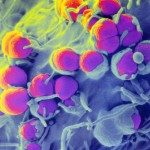Lien vers Pubmed [PMID] – 20199594
Mol. Microbiol. 2010 Mar;75(6):1550-62
The adenylate cyclase toxin-haemolysin of Bordetella (CyaA) targets CD11b(+) myeloid phagocytes and translocates across their cytoplasmic membrane an adenylate cyclase (AC) enzyme that catalyses conversion of cytosolic ATP into cAMP. In parallel, CyaA acts as a cytolysin forming cation-selective pores, which permeabilize cell membrane and eventually provoke cell lysis. Using cytolytic activity, potassium efflux and patch-clamp assays, we show that a combination of substitutions within the pore-forming (E570Q) and acylation-bearing domain (K860R) ablates selectively the cell-permeabilizing activity of CyaA. At the same time, however, the capacity of such mutant CyaA to translocate the AC domain across cytoplasmic membrane into cytosol of macrophage cells and to elevate cellular cAMP concentrations remained intact. Moreover, the combination of E570Q+K860R substitutions suppressed the residual cytolytic activity of the enzymatically inactive CyaA/OVA/AC(-) toxoid on CD11b-expressing monocytes, while leaving unaffected the capacity of the mutant toxoid to deliver in vitro a reporter CD8(+) T cell epitope from ovalbumin (OVA) to the cytosolic pathway of dendritic cells for MHC class I-restricted presentation and induce in vivo an OVA-specific cytotoxic T cell response. CyaA, hence, employs a mechanism of AC enzyme domain translocation across cellular membrane that avoids passage across the cytolytic pore formed by toxin oligomers.


